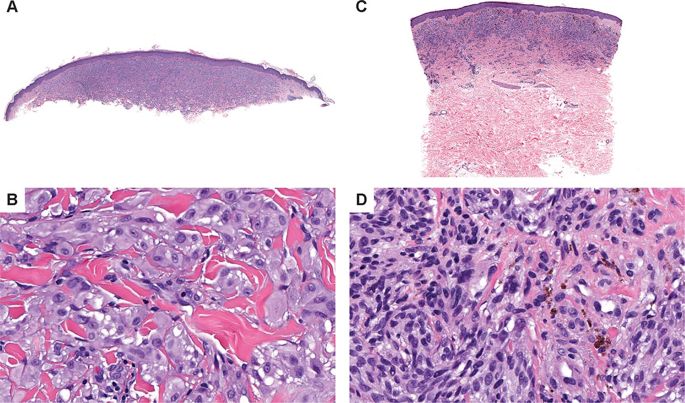当前位置:
X-MOL 学术
›
Modern Pathol.
›
论文详情
Our official English website, www.x-mol.net, welcomes your
feedback! (Note: you will need to create a separate account there.)
Spitz melanoma is a distinct subset of spitzoid melanoma.
Modern Pathology ( IF 7.1 ) Pub Date : 2020-01-03 , DOI: 10.1038/s41379-019-0445-z Shyam S Raghavan 1 , Sandra Peternel 2, 3 , Thaddeus W Mully 2 , Jeffrey P North 2 , Laura B Pincus 2 , Philip E LeBoit 2 , Timothy H McCalmont 2 , Boris C Bastian 2 , Iwei Yeh 2
Modern Pathology ( IF 7.1 ) Pub Date : 2020-01-03 , DOI: 10.1038/s41379-019-0445-z Shyam S Raghavan 1 , Sandra Peternel 2, 3 , Thaddeus W Mully 2 , Jeffrey P North 2 , Laura B Pincus 2 , Philip E LeBoit 2 , Timothy H McCalmont 2 , Boris C Bastian 2 , Iwei Yeh 2
Affiliation

|
Melanomas that have histopathologic features that overlap with those of Spitz nevus are referred to as spitzoid melanomas. However, the diagnostic concept is used inconsistently and genomic analyses suggest it is a heterogeneous category. Spitz tumors, the spectrum of melanocytic neoplasms extending from Spitz nevi to their malignant counterpart Spitz melanoma, are defined in the 2018 WHO classification of skin tumors by the presence of specific genetic alterations, such as kinase fusions or HRAS mutations. It is unclear what fraction of "spitzoid melanomas" defined solely by their histopathologic features belong to the category of Spitz melanoma or to other melanoma subtypes. We assembled a cohort of 25 spitzoid melanomas diagnosed at a single institution over an 8-year period and performed high-coverage DNA sequencing of 480 cancer related genes. Transcriptome wide RNA sequencing was performed for select cases. Only nine cases (36%) had genetic alterations characteristic of Spitz melanoma, including HRAS mutation or fusion involving BRAF, ALK, NTRK1, or MAP3K8. The remaining cases were divided into those with an MAPK activating mutation and those without an MAPK activating mutation. Both Spitz melanoma and spitzoid melanomas in which an MAPK-activating mutation could not be identified tended to occur in younger patients on skin with little solar elastosis, infrequently harbored TERT promoter mutations, and had a lower burden of pathogenic mutations than spitzoid melanomas with non-Spitz MAPK-activating mutations. The MAPK-activating mutations identified affected non-V600 residues of BRAF as well as NRAS, MAP2K1/2, NF1, and KIT, while BRAF V600 mutations, the most common mutations in melanomas of the WHO low-CSD category, were entirely absent. While the "spitzoid melanomas" comprising our cohort were enriched for bona fide Spitz melanomas, the majority of melanomas fell outside of the genetically defined category of Spitz melanomas, indicating that histomorphology is an unreliable predictor of Spitz lineage.
中文翻译:

斯皮茨黑色素瘤是斯皮茨样黑色素瘤的一个独特亚型。
具有与斯皮茨痣重叠的组织病理学特征的黑色素瘤被称为斯皮茨样黑色素瘤。然而,诊断概念的使用不一致,基因组分析表明它是一个异质类别。Spitz 肿瘤是从 Spitz 痣延伸到其恶性对应的 Spitz 黑色素瘤的黑素细胞肿瘤谱系,在 2018 年 WHO 皮肤肿瘤分类中通过存在特定的基因改变(例如激酶融合或 HRAS 突变)来定义。目前尚不清楚仅由其组织病理学特征定义的“斯皮茨样黑色素瘤”的哪一部分属于斯皮茨黑色素瘤类别或其他黑色素瘤亚型。我们收集了 8 年期间在同一机构诊断出的 25 例斯皮茨样黑色素瘤队列,并对 480 个癌症相关基因进行了高覆盖率 DNA 测序。对选定的病例进行了转录组全 RNA 测序。只有 9 例 (36%) 具有 Spitz 黑色素瘤特征的基因改变,包括 HRAS 突变或涉及 BRAF、ALK、NTRK1 或 MAP3K8 的融合。其余病例分为有 MAPK 激活突变的病例和无 MAPK 激活突变的病例。无法识别 MAPK 激活突变的斯皮茨黑色素瘤和斯皮茨样黑色素瘤往往发生在皮肤上很少有日光性弹性组织变性的年轻患者中,很少含有 TERT 启动子突变,并且与非非斯皮茨样黑色素瘤相比,致病性突变的负担较低。 Spitz MAPK 激活突变。确定的 MAPK 激活突变影响 BRAF 以及 NRAS、MAP2K1/2、NF1 和 KIT 的非 V600 残基,而 BRAF V600 突变(WHO 低 CSD 类别黑色素瘤中最常见的突变)完全不存在。虽然组成我们队列的“斯皮茨样黑色素瘤”富含真正的斯皮茨黑色素瘤,但大多数黑色素瘤不属于基因定义的斯皮茨黑色素瘤类别,这表明组织形态学是斯皮茨谱系的不可靠预测因子。
更新日期:2020-01-04
中文翻译:

斯皮茨黑色素瘤是斯皮茨样黑色素瘤的一个独特亚型。
具有与斯皮茨痣重叠的组织病理学特征的黑色素瘤被称为斯皮茨样黑色素瘤。然而,诊断概念的使用不一致,基因组分析表明它是一个异质类别。Spitz 肿瘤是从 Spitz 痣延伸到其恶性对应的 Spitz 黑色素瘤的黑素细胞肿瘤谱系,在 2018 年 WHO 皮肤肿瘤分类中通过存在特定的基因改变(例如激酶融合或 HRAS 突变)来定义。目前尚不清楚仅由其组织病理学特征定义的“斯皮茨样黑色素瘤”的哪一部分属于斯皮茨黑色素瘤类别或其他黑色素瘤亚型。我们收集了 8 年期间在同一机构诊断出的 25 例斯皮茨样黑色素瘤队列,并对 480 个癌症相关基因进行了高覆盖率 DNA 测序。对选定的病例进行了转录组全 RNA 测序。只有 9 例 (36%) 具有 Spitz 黑色素瘤特征的基因改变,包括 HRAS 突变或涉及 BRAF、ALK、NTRK1 或 MAP3K8 的融合。其余病例分为有 MAPK 激活突变的病例和无 MAPK 激活突变的病例。无法识别 MAPK 激活突变的斯皮茨黑色素瘤和斯皮茨样黑色素瘤往往发生在皮肤上很少有日光性弹性组织变性的年轻患者中,很少含有 TERT 启动子突变,并且与非非斯皮茨样黑色素瘤相比,致病性突变的负担较低。 Spitz MAPK 激活突变。确定的 MAPK 激活突变影响 BRAF 以及 NRAS、MAP2K1/2、NF1 和 KIT 的非 V600 残基,而 BRAF V600 突变(WHO 低 CSD 类别黑色素瘤中最常见的突变)完全不存在。虽然组成我们队列的“斯皮茨样黑色素瘤”富含真正的斯皮茨黑色素瘤,但大多数黑色素瘤不属于基因定义的斯皮茨黑色素瘤类别,这表明组织形态学是斯皮茨谱系的不可靠预测因子。











































 京公网安备 11010802027423号
京公网安备 11010802027423号